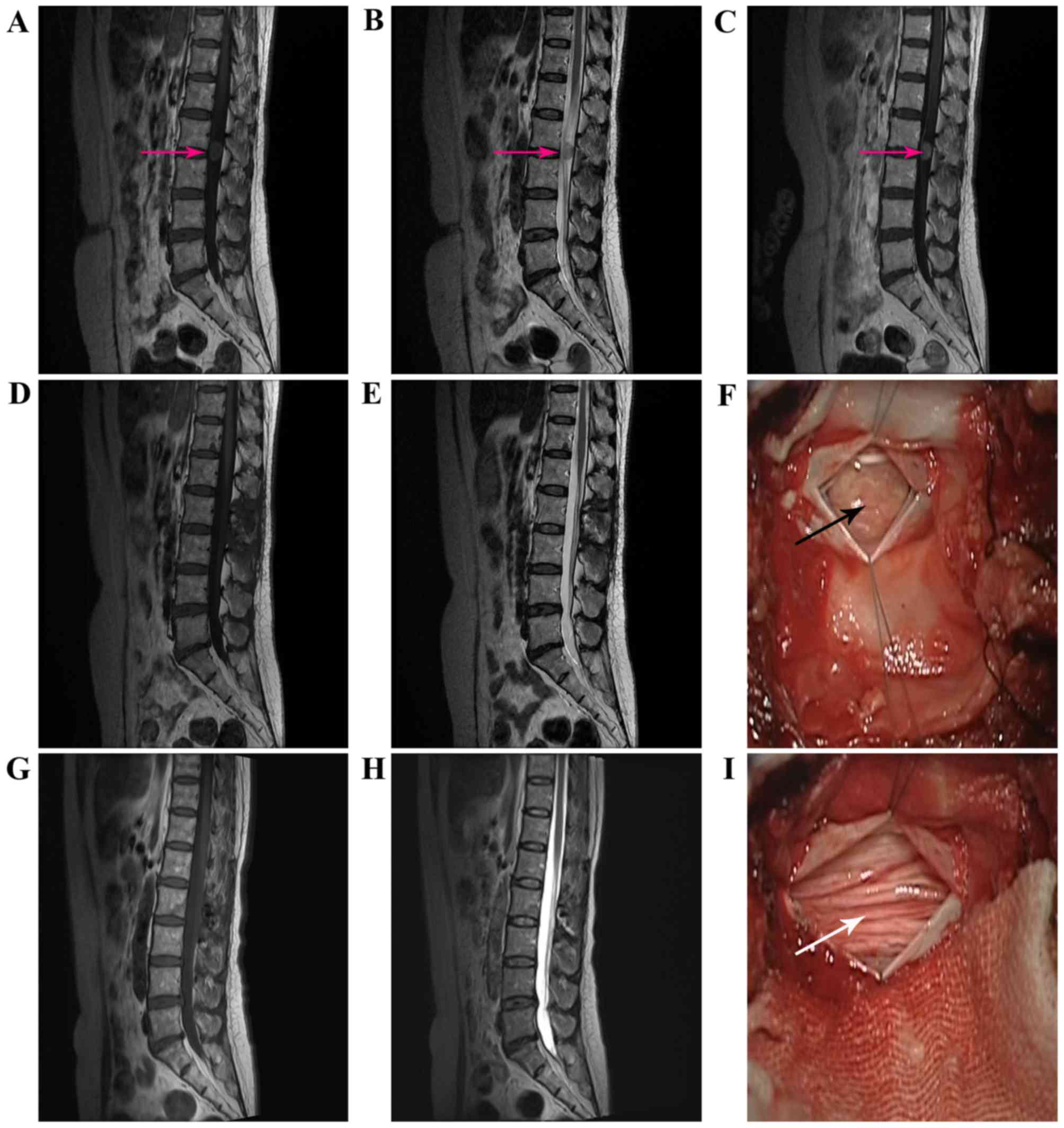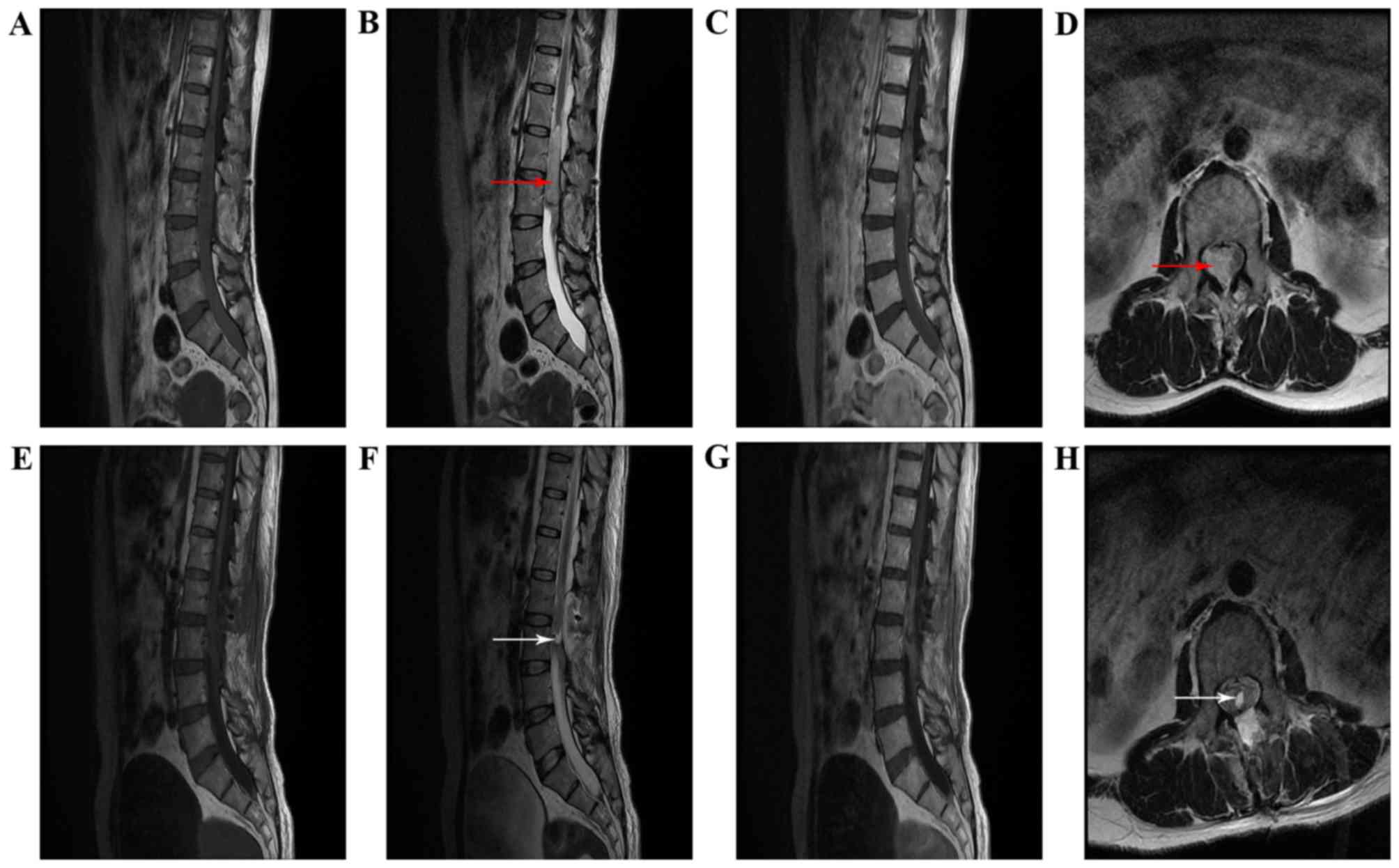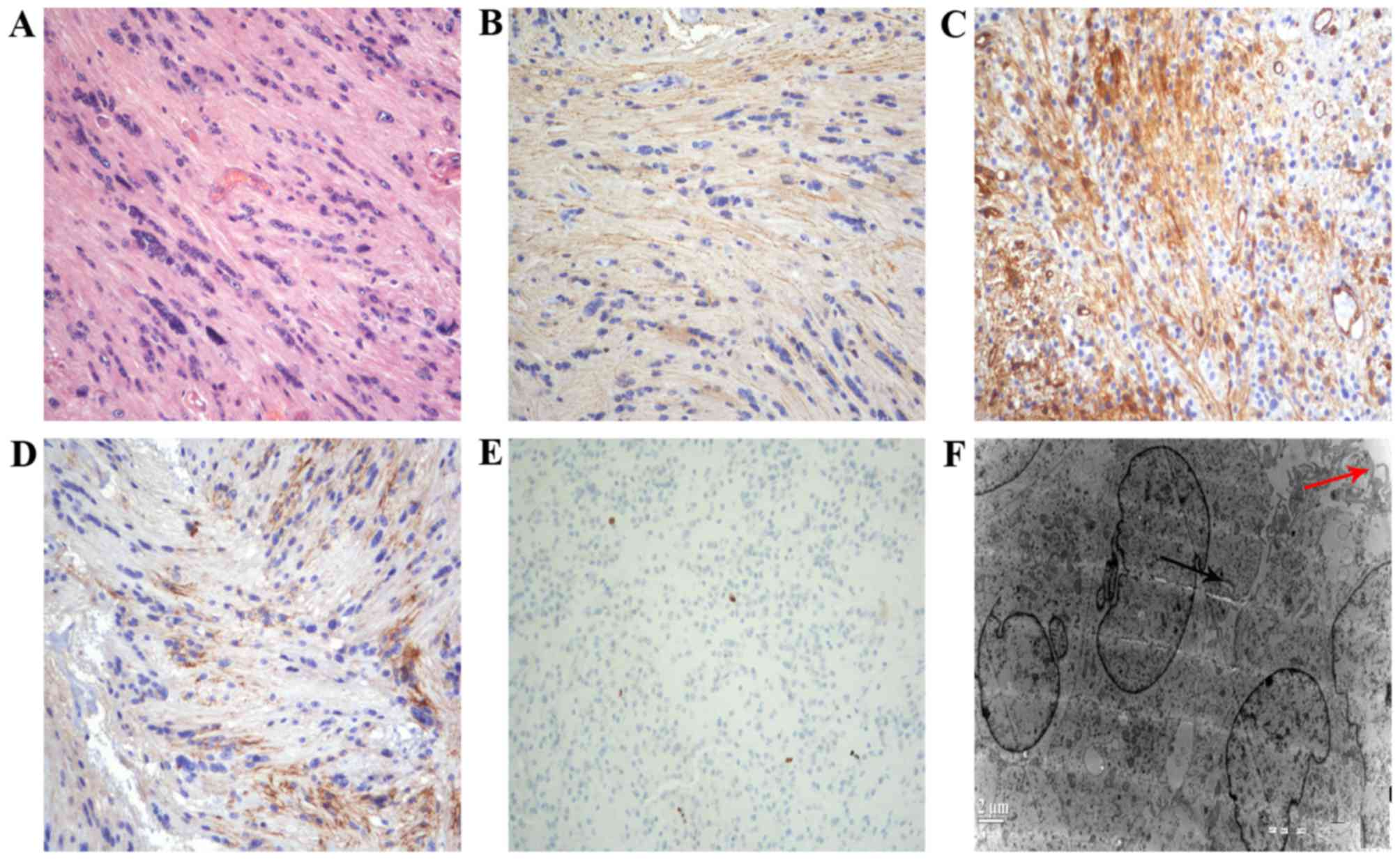|
1
|
Gilbert MR, Ruda R and Soffietti R:
Ependymomas in adults. Curr Neurol Neurosci Rep. 10:240–247. 2010.
View Article : Google Scholar : PubMed/NCBI
|
|
2
|
Cepeda S, Hernández-Laín A, Munarriz PM,
González Martinez MA and Lagares A: Spinal tanycytic ependymoma
associated with neurofibromatosis type 2. Clin. Neuropathol.
33:311–314. 2014.
|
|
3
|
Friede RL and Pollak A: The cytogenetic
basis for classifying ependymomas. J Neuropathol Exp Neurol.
37:103–118. 1978. View Article : Google Scholar : PubMed/NCBI
|
|
4
|
Ragel BT, Townsend JJ, Arthur AS and
Couldwell WT: Intraventricular tanycytic ependymoma: Case report
and review of the literature. J Neurooncol. 71:189–193. 2005.
View Article : Google Scholar : PubMed/NCBI
|
|
5
|
Liu Z, Li J, Liu Z, Wang Q, Famer P, Mehta
A, Chalif D, Wang Y and Li JY: Supratentorial cortical ependymoma:
Case series and review of the literature. Neuropathology.
34:243–252. 2014. View Article : Google Scholar : PubMed/NCBI
|
|
6
|
Radhakrishnan N, Nair NS, Hingwala DR,
Kapilamoorthy TR and Radhakrishnan VV: Tanycytic ependymoma of
filum terminale: A case report. Clin Neur Neurosurg. 114:169–171.
2012. View Article : Google Scholar
|
|
7
|
Ydel Ortiz M, Pérez Berenguer JL, Acosta
Mercado J, Polo M, de Jesús-Garces O and Vega IE: Tanycytic
ependymoma in a 76-year-old Puerto Rican male. Int J Clin Exp
Pathol. 7:7789–7794. 2014.PubMed/NCBI
|
|
8
|
Mohindra S, Bal A and Singla N: Pediatric
tanycytic ependymoma of the cauda equina: Case report and review of
the literature. J Child Neurol. 23:451–454. 2008. View Article : Google Scholar : PubMed/NCBI
|
|
9
|
Shintaku M and Sakamoto T: Tanycytic
ependymoma of the filum terminale with pleomorphic giant cells.
Brain Tumor Pathol. 26:79–82. 2009. View Article : Google Scholar : PubMed/NCBI
|
|
10
|
Funayama T, Sakane M, Yoshizawa T,
Takeuchi Y and Ochiai N: Tanycytic ependymoma of the filum
terminale associated with multiple endocrine neoplasia type 1:
First reported case. Spine J. 13:e49–e54. 2013. View Article : Google Scholar : PubMed/NCBI
|
|
11
|
Tomek M, Jayajothi A, Brandner S,
Jaunmuktane Z, Lee CH and Davagnanam I: Imaging features of spinal
tanycytic ependymoma. Neuroradiol J. 29:61–65. 2016. View Article : Google Scholar : PubMed/NCBI
|
|
12
|
Spaar FW, Blech M and Ahyai A: DNA-flow
fluorescence-cytometry of ependymomas. Report on ten surgically
removed tumours. Acta Neuropathol. 69:153–160. 1986. View Article : Google Scholar : PubMed/NCBI
|
|
13
|
Langford LA and Barré GM: Tanycytic
ependymoma. Ultrastruct Pathol. 21:135–142. 1997. View Article : Google Scholar : PubMed/NCBI
|
|
14
|
Dvoracek MA and Kirby PA: Intraoperative
diagnosis of tanycytic ependymoma: Pitfalls and differential
diagnosis. Diagn Cytopathol. 24:289–292. 2001. View Article : Google Scholar : PubMed/NCBI
|
|
15
|
Kawano N, Yagishita S, Oka H, Utsuki S,
Kobayashi I, Suzuki S, Tachibana S and Fujii K: Spinal tanycytic
ependymomas. Acta Neuropathol. 101:43–48. 2001.PubMed/NCBI
|
|
16
|
Kobata H, Kuroiwa T, Isono N, Nagasawa S,
Ohta T and Tsutsumi A: Tanycytic ependymoma in association with
neurofibromatosis type 2. Clin Neuropathol. 20:93–100.
2001.PubMed/NCBI
|
|
17
|
Ueki K, Sasaki T, Ishida T and Kirino T:
Spinal tanycytic ependymoma associated with neurofibromatosis type
2-case report. Neurol Med Chir (Tokyo). 41:513–516. 2001.
View Article : Google Scholar : PubMed/NCBI
|
|
18
|
Boccardo M, Telera S and Vitali A:
Tanycytic ependymoma of the spinal cord. Case report and review of
the literature. Neurochirurgie. 49:605–610. 2003.PubMed/NCBI
|
|
19
|
Ito T, Ozaki Y, Nakagawara J, Nakamura H,
Tanaka S and Nagashima K: A case of cervicomedullary junction
tanycytic ependymoma associated with marked cyst formation. Brain
Tumor Pathol. 22:29–33. 2005. View Article : Google Scholar : PubMed/NCBI
|
|
20
|
Sato K, Kubota T, Ishida M and Handa Y:
Spinal tanycytic ependymoma with hematomyelia-case report. Neurol
Med Chir (Tokyo). 45:168–171. 2005. View Article : Google Scholar : PubMed/NCBI
|
|
21
|
Shintaku M, Nagata N and Itoh H: Tanycytic
ependymoma of the spinal cord with anaplastic cytological features.
Brain Tumor Pathol. 26:7–10. 2009. View Article : Google Scholar : PubMed/NCBI
|
|
22
|
Du J, Zhou X, Tang Q, Ma H, Zhou H, Wang
J, Lu Z and Yin H: Tanycytic ependymoma: Two case reports and
review of the literature. Comp Clin Pathol. 18:449–453. 2009.
View Article : Google Scholar
|
|
23
|
Lim BS, Park SQ, Chang UK and Kim MS:
Spinal cord tanycytic ependymoma associated with neurofibromatosis
type 2. J Clin Neurosci. 17:922–924. 2010. View Article : Google Scholar : PubMed/NCBI
|
|
24
|
Ishihama H, Nakamura M, Funao H, Ishii K,
Matsumoto M, Toyama Y and Chiba K: A rare case of spinal dumbbell
tanycytic ependymoma. Spine (Phila Pa 1976). 36:E612–E614. 2011.
View Article : Google Scholar : PubMed/NCBI
|
|
25
|
Tosun O, Turkoglu OF, Ozmen EK, Onursever
A and Arslan H: Spinal tanycytic ependymoma with diffusion
restriction on MRI. Acta Neurol Belg. 112:77–80. 2012. View Article : Google Scholar : PubMed/NCBI
|
|
26
|
Krisht KM and Schmidt MH: Tanycytic
ependymoma: A challenging histological diagnosis. Case Rep Neurol
Med. 2013:1707912013.PubMed/NCBI
|
|
27
|
Kuga Y, Ohnishi H, Kodama Y, Takakura S,
Hayashi M, Yagi R, Matsushima K, Okamoto K, Taomoto K and Takahashi
H: Cerebral and spinal cord tanycytic ependymomas in a young adult
with a mutation in the NF2 gene. Neuropathology. 34:406–413.
2014.PubMed/NCBI
|
|
28
|
Furlan JC, Chui MH, Croul SE and Kongkham
P: Mystery case: Tanycytic ependymoma of the conus medullaris: A
rare cause of low back pain. Neurology. 82:e212–e213. 2014.
View Article : Google Scholar : PubMed/NCBI
|
|
29
|
Maugeri R, Giugno A, Graziano F, Visocchi
M, Giller C and Iacopino DG: Delayed chronic intracranial subdural
hematoma complicating resection of a tanycytic thoracic ependymoma.
Surgical Neurol Int. 7 Suppl 1:S20–S22. 2016. View Article : Google Scholar
|
|
30
|
Singla N, Kapoor A, Radotra BD and
Chatterjee D: Tanycytic ependymoma of cervical cord presenting with
spontaneous intratumoral hemorrhage. Spine J. 16:e733–e734. 2016.
View Article : Google Scholar : PubMed/NCBI
|
|
31
|
Rigante L, Novello M, Massimi L and
Caldarelli M: A cortical cystic epileptogenic lesion: Tanycytic
ependymoma. Acta Neurol Belg. 113:523–525. 2013. View Article : Google Scholar : PubMed/NCBI
|
|
32
|
Divito A, Keller JT, Hagen M and
Zuccarello M: Vestibular schwannoma or tanycytic ependymoma:
Immunohistologic staining reveals. Surg Neurol Int. 5:1582014.
View Article : Google Scholar : PubMed/NCBI
|
|
33
|
Agarwal S, Stevenson ME, Sughrue ME,
Wartchow EP, Mierau GW and Fung KM: Features of intraventricular
tanycytic ependymoma: Report of a case and review of literature.
Int J Clin Exp Pathol. 7:3399–3407. 2014.PubMed/NCBI
|
|
34
|
Radner H, Blümcke I, Reifenberger G and
Wiestler OD: The new WHO classification of tumors of the nervous
system 2000. Pathologe. 23:260–283. 2002.(In German). View Article : Google Scholar : PubMed/NCBI
|
|
35
|
Dimopoulos VG, Fountas KN and Robinson JS:
Familial intracranial ependymomas. Report of three cases in a
family and review of the literature. Neurosurg Focus.
20:E82006.PubMed/NCBI
|
|
36
|
Erdogan E, Ongürü O, Bulakbasi N, Baysefer
A, Gezen F and Timurkaynak E: Schwannoma of the lateral ventricle:
Eight-year follow-up and literature review. Minim Invasive
Neurosurg. 46:50–53. 2003. View Article : Google Scholar : PubMed/NCBI
|
|
37
|
Shukla S, Malhotra KP, Awasthi NP, Husain
N and Singh SK: Intraventricular tanycytic ependymoma: An uncommon
fibrillary variant. Neurol India. 62:200–201. 2014. View Article : Google Scholar : PubMed/NCBI
|
|
38
|
Kambe A, Kurosaki M, Watanabe T and
Nakazato Y: Pediatric supratentorial cortical tanycytic ependymoma
associated with absence seizures. Clin Neuropathol. 33:308–310.
2014.PubMed/NCBI
|
|
39
|
Zhang S, Wang X, Zhang Z and Chen Y:
Tanycytic ependymoma arising from the right lateral ventricle: A
case report and review of the literature. Neuropathology.
28:427–432. 2008. View Article : Google Scholar : PubMed/NCBI
|

















